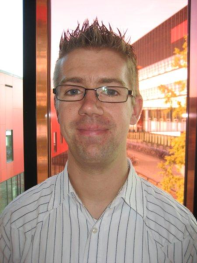Theory and design of microwave photonic free-electron lasers
Promotion date: December 14.
Promotor: Prof. dr. Klaus Boller
Assistant promotor: Dr. Peter van der Slot
| Coherent electromagnetic waves are extensively used in various fields of research and many applications. Almost every part of the electromagnetic spectrum, ranging from radio waves to hard X-rays, has been put to work with great success for the benefit of mankind. Therefore, despite a huge variety of existing sources of electromagnetic waves, there is a continuous demand for novel sources with improved properties tailored to particular needs. I have studied a novel type of photonic-crystal laser based on coherent emission from free electrons, which we call: the photonic free-electron laser (pFEL). The central question of my thesis was whether a pFEL can be implemented as a compact, frequency scalable, high power laser. Especially, as such pFEL has never been realized, the answer to this question is far from simple. A systematic numerical study of such lasers proves that pFELs are indeed promising for tunable high-power laser sources for the microwave and also are promising sources for THz radiation. |
Why are free-electron lasers investigated?
Free-electron lasers are of high interest in spectral regions that are difficult to access with other laser sources. For example, at Terahertz frequencies a ‘gap’ exists where no powerful lasers are readily available. However, Terahertz sources are widely needed to find solutions in detecting the spectral fingerprint of organic molecules, for example. Therefore, free-electron lasers are used to proved THz radiation.
In the Netherlands, in Nijmegen, two free electron laser facilities are in use at the moment, positioned in a special building. In our research effort at the Laser Physics and Nonlinear Optics group, we are looking for ways to produce these laser sources in a smaller, cheaper and easy-to-handle apparatus and eventually, towards the size of a chip.
For the first years of my PhD project, efforts were aimed at modelling the working principle of the laser, which is based on shaping the emission of the electrons by using photonic crystals. Now we are focussing on generating light in an experimental setup. We are convinced our approach will succeed and the principle will be characterized. If realisation under practical conditions is not feasible in my PhD period, I am sure my colleague will solve the remaining hurdles to do so, within a few weeks.
Did you manage to have some nice publications?
A brief overview of our idea was published as a Breakthroughs in Photonics 2011 in the IEEE Journal of Photonics (http://www.photonicsjournal.org/Breakthroughs-in-Photonics-2011.pdf). Two more publication, presenting the laser in more detail, are currently in preparation and will be published soon after my graduation. Also an article appeared in Optics Express (http://www.opticsinfobase.org/oe/abstract.cfm?URI=oe-20-20-22902). Here, an approach well-known in the microwave community is taken and applied to photonic crystals, which has never been done before. Notably, this publication is the result of the close cooperation inside MESA+ via the strategic research orientation Applied Nanophotonics. Complex Photonic Systems chair Willem Vos encouraged me to publish these findings by pointing out the importance of the novel technique.
In what way did you develop personally as a scientist and researcher?
I believe my abilities as a scientist and researcher have been growing during my time as a PhD. By pushing the limits – and by allowing oneself to also fail on some aspects of research – I got to recognize my skills on various topics. Also I learned to develop my supervising skills. I cooperated on projects with students quite successfully, I am proud to say. In two articles the student researchers are mentioned as a co-author, and will be mentioned in two more articles. What I like most is getting challenged by the questions they come up with and discussing the themes arising from it, in an open and constructive way.
What are your future plans?
First of all, I promised myself a period of repose by visiting New Zealand and Australia for a few months. I would like to continue performing research, either in academics or at a research centre or a knowledge institution. I would like to stay in Europe doing so. I really appreciate the open and non-hierarchic working atmosphere in the Netherlands, which is different to my home country Germany. I hope to find this in the future as well because it fits my personal preference very well.
What, in your opinion, is important for Mesa+ to stay successful in the future?
I guess, it is important for Mesa+ to be open-minded of developments at all levels, not only focussing on nanoscale technology, but also to remain exploring the fundamentals of physics which in the end determine the capabilities of any technology. In my opinion one very positive step in this direction are the Strategic Research Orientation groups. They seem to allow to freely investigate a certain direction that is at the crossing point of several groups, in that way stimulating new ideas but also leading to a closer collaboration between existing research groups.

